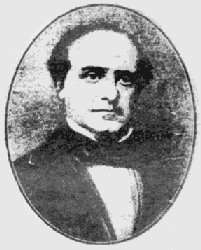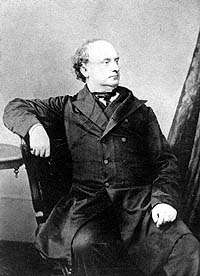Ernest Charles Jones
- For other persons named Ernest Jones, see Ernest Jones
- For other persons named Ernie Jones, see Ernie Jones

Ernest Charles Jones (25 January 1819 – 26 January 1869), was an English poet, novelist, and Chartist.
Early life
Jones was born on 25 January 1819 in Berlin, while his parents were visiting the Prussian court.[1] He was the son of a British Army Major named Charles Gustav Jones, equerry to the Duke of Cumberland, afterwards King of Hanover.[2] In 1838 Jones came to England,[2] and in 1841 published anonymously The Wood-Spirit,[3] a romantic novel.[4] This was followed by some songs and poems. He entered the Middle Temple in 1841 and on 20 April 1844 he was called to the bar.[5]
Chartism
In 1845 he joined the Chartist agitation, quickly becoming its most prominent figure, and vigorously carrying on the party's campaign on the platform and in the press. His speeches, in which he openly advocated physical force, led to his prosecution, and he was sentenced in 1848 to two years' imprisonment for seditious speeches.[6] While in prison he wrote, it is said in his own blood on leaves torn from a prayer-book, The Revolt of Hindostan, an epic poem.
Upon his release from prison, he conducted a Chartist newspaper: the "Notes to The People" (1850–1852). He became a leading figure in the "National Charter Association" in the phase of its decline, together with his friend George Julian Harney, and helped to give the Chartist movement a clearer socialist direction. He knew Karl Marx[7] and Friedrich Engels[8] personally. Marx and Engels at the same time commented on the Chartist movement and Jones' work in their letters and articles. But he was almost its only public speaker; he was out of sympathy with the other leading Chartists, and soon joined the advanced Radical party. Jones was a member of the Manchester section of the International Workingmen's Association.[9]
Return to Convention

Afterwards, when the political and social agitation had died down, he returned to his practice as a barrister, which he had deserted, and also wrote largely. He produced a number of novels, including The Maid of Warsaw and Woman's Wrongs, also some poems, The Painter of Florence,The Battle Day (1855), The Revolt of Hindostan (1857), and Corayda (1859). Some of his lyrics, such as The Song of the Poor, The Song of the Day Labourers, and The Factory Slave, were well known.
Death
He made several unsuccessful attempts to enter parliament and was about to contest Manchester, with the certainty of being returned, when he died in Ardwick, Manchester in 1869. He is buried in Ardwick Cemetry.[10] He is believed to have sacrificed a considerable fortune rather than abandon his Chartist principles. His wife was Jane Atherley; and his son, Llewellyn Atherley-Jones, K.C. (1851–1929), was a barrister and Liberal Member of Parliament.
Works
- Infantine effusions. F. H. Nestler, Hamburg 1830 Digitalisat
- The Wood-Spirit. A Novel. T. W. Boone, London 1841 Band 1 Digitalisat
- Fergus O'Connor, Ernst Charles Jones (Hrsg.): The Labourer; A monthly magazin of politics, literature, poetry & c. Bd. 1. Northern Star Office, Manchester 1847 Digitalisat
- Fergus O'Connor, Ernst Charles Jones (Hrsg.): The Labourer; A monthly magazin of politics, literature, poetry & c. Bd. 2. Northern Star Office, Manchester 1847 Digitalisat
- Fergus O'Connor, Ernst Charles Jones (Hrsg.): The Labourer; A monthly magazin of politics, literature, poetry & c. Nd. 3. Northern Star Office, Manchester 1848 Digitalisat
- Fergus O'Connor, Ernst Charles Jones (Hrsg.): The Labourer; A monthly magazin of politics, literature, poetry & c. Northern Star Office, Manchester 1848 Digitalisat
- Hrsg.: Notes to the People. The Champion of Political Justice and Universal Right. London May 1851 until 1858 Digitalisat 1851
- Co-operation. In: Notes to the People. Nro. 21. September, 20th 1851[11]
- Three to One. In: Notes to the People. Nro. 26 25 September 1851[12]
- What Is Kossuth? In: Notes to the People. Nro. 31 vom 29 November 1851[13]
- Erklärung gegen Karl Heinzen. Übersetzt von Jenny Marx. London March 1852, 3rd.[14]
- The Coming Crisis and why It Is Coming. In: Notes to the People. Nro. 16 August, 21st 1852[15]
- The Storm's First Thunder. In: Notes to the People. Nro. 42 February, 19th 1853[16]
- A Phamphlet on the „Revelations Concerning the Trial of the Communists at Cololone“. In: Notes to the People. Nro. 47 26. 26 March 1853[17]
- Secret Intrigue of Russian Tools, and Scandalous Doings of „Our“ Cabinet in the East. In: Notes to the People. Nro. 86 24. Dezember, 24th 1853[18]
- Different Features of Popular Feeling. In: Notes to the People. Nro. 103 April, 22nd 1854[19]
- Discoveries Made Too Late. In: Notes to the People. Nro. 130 28. Oktober, 28th 1854[20]
- The Maid of Warsaw, or the Tyrant Czar: a tale of the last Polish Insurrection. London 1854
- Woman's Wrongs. A series of tales. London 1855
- Evenings with the People. The Franchise and Taxation, an address. London 1856 Digitalisat
- Evenings with the people. The unemployed. London 1857[21]
- The revolut of Hindostan; or the new world. A. poem. Wilson, London 1857[22]
- Corayda. A Tale of Faith and Chibalry, and other poems. W. Kent & Co., London 1860 Digitalisat
- Communist Party of Great Britain History Group Corporation (Hrsg.): Diary of Ernest Jones 1839–47. Hammersmith, London 1961 (Our history 21)
Further reading
- The Queen against Ernest Jones. Trial of Ernest Charles Jones for sedition and unlawful assembly at the Central Criminal Court before Wilde, C.J., 10 July 1848. o. O. 1848
- James Crossley: Ernest Jones. Who is he? What has he done?. A. Heywood, Manchester 1857
- Wm. Sharman: Reform or revolution. Songs for the march. Dedicated by permission to Ernest Jones, confessor for freedom in 1848. Collected and edited by the Rev. Wm. Sharman, Bradford. F. Farrah, London 1867
- The life and death of Ernest Jones the Chartist reformer. A memoir. Manchester 1869
- Frederick Leary: The Life of Ernest Jones. „Democrat“ Publishing Office, London 1887 Digitalisat
- George Douglas Howard Cole: Ernest Jones. In: derselbe: Chartist portraits. Macmillan, London 1941
- Charlotte Alice Faber: Ernest Jones and the Chartist movement. University of Wisconsin 1904 Digitalisat
- Ernest Jones and Chartism c. 1856. In: International Institute of Social History. Bulletin of the International Institute for Social History, Amsterdam. Brill, Leiden 1950 ISSN 1873-0841 Bd. 5.1950, 2 (08), pp. 99–104
- Ernst Jones. Chartist. Selections from the writings and speeches of Ernest Jones with introd. and notes by John Saville. Lawrence & Wishart, London 1952
- de J, Fr.: An Open Letter from Ernest Jones to Weydemeyer. In: International Institute of Social History. Bulletin of the International Institute for Social History, Amsterdam. Brill, Leiden 1952 ISSN 1873-0841 Bd. 7.1952, 3 (Dez.), pp. 181–189
- W. Galkin: Ernest Jones. In: Marx und Engels und die ersten proletarischen Revolutionäre. Dietz Verlag, Berlin 1965, pp. 456–496 und 551–554
- Hans-Jürgen Bochinski: Zu den Indien-Artikeln von Ernest Jones aus dem Jahre 1853. In: Beiträge zur Marx-Engels-Forschung 3, Berlin 1978, pp. 37–44
- Stephan Lieske: Der Chartistenführer Ernest Jones. Sein Beitrag zur Entwicklung einer proletarischen Dichtung. Potsdam 1985 (Potsdam, Pädagog. Hochschule, Hist.-Phil. Fak., Dis. (A), 1985)
- Ingolf Neunübel: Marx' und Engels' Einfluß auf Ernest Jones' Chartistenblätter „Notes to the People“ und „The People's Paper“ (1851/1852). In: Marx-Engels-Jahrbuch 8, Dietz Verlag, Berlin 1985, pp. 153–187
- Ingolf Neunübel: Über die Beziehungen von Karl Marx und Friedrich Engels zur Chartistenbewegung in den fünfziger Jahren des 19. Jahrhunderts. Ihre Zusammenarbeit mit dem Führer der revolutionären Chartisten * Ingolf Neunübel:Ernest Jones im Kampf um die Reorganisation des Chartismus auf revolutionärer Grundlage. Berlin 1986 (Institut für Marxismus-Leninismus beim ZK der SED, Diss., 1986)
- Ingolf Neunübel: Zu einigen ausgewählten Fragen und Problemen der Zusammenarbeit von Marx und Engels mit dem Führer der revolutionären Chartisten, Ernest Jones, im Jahre 1854. In: Beiträge zur Marx-Engels-Forschung 22. 1987, pp. 208–217
- Miles Taylor: "Ernest Jones, Chartism and the Romance of Politics, 1819 – 1869", Oxford University Press 2003.
Notes
- ↑ Crossley, J (1867). Ernest Jones. Who is he? What has he done?. Manchester: A Heywood and Son. p. 3.
- 1 2 Saville 1952, p. 13.
- ↑ Jones, Ernest (17 March 2011). "The Wood-Spirit: a novel.". British Library, Historical Print Editions.
- ↑ Rennie, Simon (2016). The Poetry of Ernest Jones. Cambridge: Modern Humanities Research Association. p. 6.
- ↑ Saville 1952, p. 14.
- ↑ Saville 1952, p. 33.
- ↑ There are 52 letters from Ernest Jones to Marx between 1851 and 1868 kept.
- ↑ There are eight letter from Ernest Jones to Engels between 1852 and 1867 kept.
- ↑ Documents of the First International. 1864–1866. Lawrence & Wishart, London 1962, pp. 62, 92, 129, 241, 271, 307.
- ↑ Frow, Edmund & Ruth (1980). Chartism in Manchester 1838-58. Manchester: Manchester Free Press. p. 26. ISBN 090693205X.
- ↑ printed in: Marx-Engels-Gesamtausgabe. Abteilung I. Band 11, pp. 464–469.
- ↑ printed in: Marx-Engels-Gesamtausgabe. Abteilung I. Band 11, pp. 470–472.
- ↑ printed in: Marx-Engels-Gesamtausgabe. Abteilung I. Band 11, pp. 473–477.
- ↑ printed in: Marx-Engels-Gesamtausgabe. Abteilung I. Band 11, pp. 478–479.
- ↑ printed in: Marx-Engels-Gesamtausgabe. Abteilung I. Band 11, S. 492–494.
- ↑ printed in: Marx-Engels-Gesamtausgabe. Abteilung I. Band 12, pp. 575–578.
- ↑ printed in: Marx-Engels-Gesamtausgabe. Abteilung I. Band 12, p. 579.
- ↑ printed in: Marx-Engels-Gesamtausgabe. Abteilung I. Band 12, S. 634–636.
- ↑ printed in: Marx-Engels-Gesamtausgabe. Abteilung I. Band 13, pp. 589–591.
- ↑ printed in: Marx-Engels-Gesamtausgabe. Abteilung I. Band 13, pp. 592–595.
- ↑ Beiträge zur Marx-Engels-Forschung 8. Berlin 1981, p. 99 Nro. 427.
- ↑ owned by Karl Marx. (Marx-Engels-Gesamtausgabe. Abteilung IV. Band 32, p. 357 Nro. 640).
References
 This article incorporates text from a publication now in the public domain: Cousin, John William (1910). A Short Biographical Dictionary of English Literature. London: J. M. Dent & Sons. Wikisource
This article incorporates text from a publication now in the public domain: Cousin, John William (1910). A Short Biographical Dictionary of English Literature. London: J. M. Dent & Sons. Wikisource This article incorporates text from a publication now in the public domain: Chisholm, Hugh, ed. (1911). "article name needed". Encyclopædia Britannica (11th ed.). Cambridge University Press.
This article incorporates text from a publication now in the public domain: Chisholm, Hugh, ed. (1911). "article name needed". Encyclopædia Britannica (11th ed.). Cambridge University Press.- Saville, John (1952). Ernest Jones Chartist. London: Lawrence & Wishart.
External links
- Musings, information & illustrations about the Chartists from Stephen Roberts
- Ursula Stange: Annotated Bibliography on Chartism and Ernest Charles Jones
- Chartist Ancestors: Where Are They Now includes an account of Jones's funeral
- Ernest Charles Jones: Chartist and Reformer – biography & selected writings at gerald-massey.org.uk
- "Archival material relating to Ernest Charles Jones". UK National Archives.
- Works by or about Ernest Charles Jones in libraries (WorldCat catalog)
- Lyrics to "The Song of the Lower Classes," set to music and recorded by Martin Carthy
